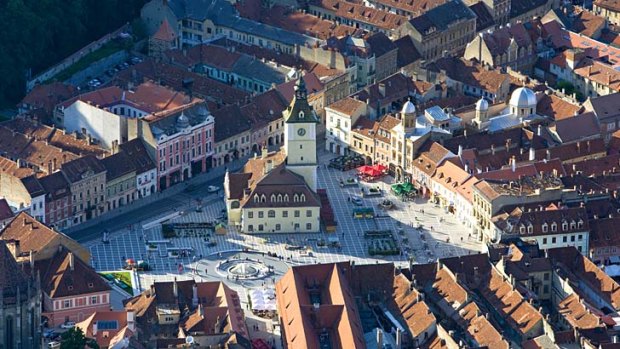
Past glory... Brasov, Romania.Credit: Getty Images
Lydia Bell explores castles, myths and their modern twists while aboard the Danube Express from Budapest to Istanbul.
Train travel is freighted with romance. I had harboured a feverish desire to travel on the Trans-Siberian and, although the reality didn't match the fantasy, would go again. I shared a tiny, unventilated compartment with a family whose rambunctious children snacked on cubes of fat, I was pursued by a Russian in the next carriage who had a tattoo-covered body and a mouth full of gold teeth, and I spent most of the time staring at a 5000-kilometre wall of birch trees.
But I appreciated the chance to see the "real" Russia - its post-industrial landscapes, remote villages and ordinary suburbia - and mark subtle changes in geography as I worked my way across its vastness. It was liberating to do away with queues, delays and all the patience-wearing aspects of travel by other means.
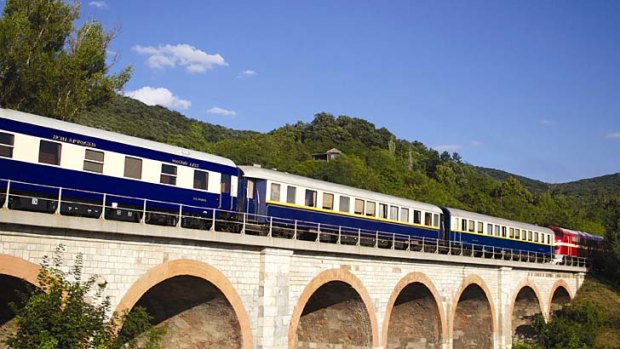
The Danube Express from Budapest to Istanbul.
Hungary's last communist president, Janos Kadar, shared my disenchantment with flying. He always travelled by train, using his government fleet to wend his way across Europe. Kadar has long since gone but his Royal Hungarian Express lives on, reincarnated as the Danube Express. The carriages are on show in the Hungarian Railway Museum, but several times a year are unleashed to go on jaunts in central and eastern Europe.
Howard Trinder, a consummate train nerd and the former owner of the British-based Great Rail Journeys, bought and restored these classic carriages in 2007. His alliance with the Hungarian company MAV Nosztalgia, which operates the Hungarian Railway Museum, re-creates train travel from another time with such route names as the Transylvanian and the Polish Explorer.
So it's because of Kadar that I'm drinking champagne in Emperor Josef II's wildly baroque royal waiting rooms at Budapest Nyugati station at 9am, in the many-mirrored hall built for Sissy, the Empress, who found high-ranking officials intensely boring and preferred her own reflection as company.
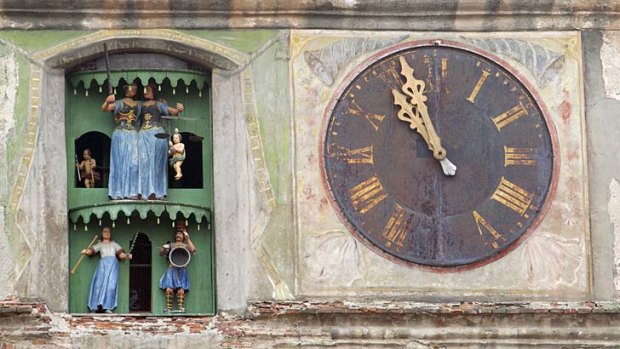
Sighisoara's clock tower.Credit: Getty Images
Soon we're ushered onto the platform to catch a glimpse of our Danube Express. It is at home in Nyugati's 1877-built fin-de-siecle grandiosity, the train's attendants lined up to shepherd their 42 passengers into eight carriages. We will be travelling from Hungary to Turkey on what's known as the Transylvanian East through Romania and Bulgaria - three nights and four days across the great Hungarian Plains, over the Carpathian Mountains and finally over the Bosphorus to Istanbul.
The carriage livery is navy and cream, solid and genteel, their vintage delightfully mixed. Trinder added to the original Royal Hungarian Express. He bought former Hungarian postal carriages and spent £500,000 revamping each. The dining and lounge cars, white tablecloths contrasted against dark wood, were built in East Germany in the 1980s. The "cheaper" carriages are 1950s vintage, classically elegant.
Our wood-panelled sleeping compartment with miniature en suite is blissfully cool and comes with a beatific attendant, Robert, who brings us coffee whenever we want and turns our sofas into beds at night. The train is comfortable, but not contemporary - it's charmingly, deliberately old-fashioned.
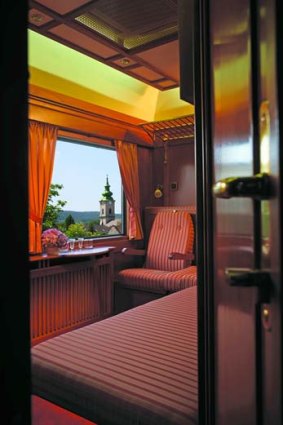
Aboard the Danube Express train.
Despite the multifarious nature of its journeys, the train itself has a Hungarian bent, from the staff to the carriages and the stolid, tasty fare - goulash, goose leg with red cabbage and dill cheesecake feature on the menu, despite the 38-degree heat that follows us across eastern Europe.
The night before departure (after enjoying excellent Hungarian wines at the Kempinski Hotel Corvinus in Budapest, interpreted by a winegrower who worked his way through the tables), I spend the evening wandering the streets of Pest's old Jewish quarter, District VII. The street lamps glow amber on once-grandiose Habsburg squares and avenues; facades unloved, haunted and beautiful. Once a ghetto, it is now home to chic bars, many of them romkocsma (ruined bars) - maze-like courtyard drinking holes where the arts intelligentsia gather.
Our first stop on board the train is Lajosmizse, where a lugubrious female voice on the intercom advises us to wear "strong shoes" as we are "soon to be stepping onto the Great Hungarian Plains", or Puszta, as they call them. The voice belongs to sweet, solemn Andrea, the train manager. Outside the window, csikosok - Hungarian cowboys in theatrical blue robes - crack giant whips. There is a saying that the Magyars were "created by God to sit on horseback". Attila the Hun and his murderous cavalry swept out of these grasslands to plague the Roman Empire. The plains, which cover two-thirds of Hungary's land mass, are so flat "you can see a dog running for three days" (or so a Romanian man tells me later on the journey).
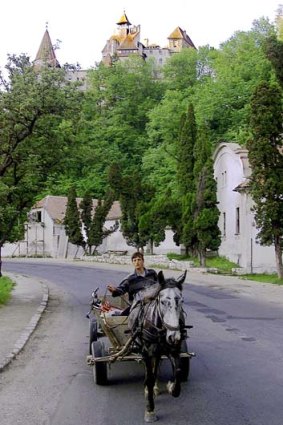
A traveller near Bran Castle.Credit: Reuters
We're transported by gypsy caravan in Lajosmizse along birch-dappled lanes to a ranch where we're plied with palinka, plum-brandy firewater and pogacsa (salty bread). There's a thundering horse parade, wartime-style riding and daredevil racing, with the rider standing bareback, one foot on each of two horses.
Our next stop, Kecskemet, is more about goats. Adam, my friend's Hungarian boyfriend, demands to know why we are stopping at a town whose translation is "goatsville". "It's on the way to my grandfather's house," he says. "Sometimes I go there to run errands. It's not a big deal." But I think that's the point of train travel - off the beaten track you pass towns that are alluring in their ordinariness.
In the main square of Kecskemet we admire the art nouveau town hall, Luther-Palace, and the Hungarian Museum of Photography. Recent history in Kecskemet still has great bearing on the present: all Jews living here were rounded up and sent to Auschwitz.
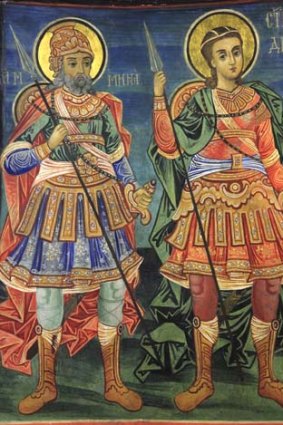
Artwork at Veliko Tarnovo.Credit: AFP
At night we dine on venison with braised pear, and strudel, and wake up in Sighisoara, in the heart of Transylvania. It's the kind of picturesque town that's the backdrop of fairytales. Founded in 1190 by Saxon craftsmen, the one-time home of Vlad the Impaler (whom some believe was the archetype of author Bram Stoker's fictional Dracula), Sighisoara mediaevalism is overwhelming. Were it not for the tacky horror-film masks and plastic vampire teeth, the modern world would seem far away. In the old clock tower we examine remnants: 19th-century homoeopathic medicines, enema syringes and surgeon's instruments. A covered staircase worthy of Hogwarts leads to School's Hill, where, from a Gothic graveyard, we admire the curve of the Tarnava Mare River and the towers funded by Saxon merchants.
The train rolls on to Brasov. In 1989, this was the second city to rise against the last Romanian communist leader, Nicolae Ceausescu. Now Republicii Street is full of young people drinking Italian coffee. Nearby is Bran Castle, a 13th-century Gothic fortress built by Teutonic knights in 1212 - and here, too, a link has been made with Dracula. The castle is allegedly Dracula's lair in Stoker's novel but the link is tenuous, at best. Dracula was a character created from strands of legends and superstition. Vlad the Impaler, one of Stoker's possible inspirations, may or may not have visited Bran. In the 1960s, it was a densely forested backwater, and the castle was cold and deserted. Then came the 1963 Christopher Lee Dracula film and locals twigged to the commercial potential. There are more than 10,000 B&Bs in Brasov these days.
Before being appropriated by the communists, Bran Castle was the family home of Queen Marie of Romania, the granddaughter of Queen Victoria and the British-born consort of the Romanian King, from 1914-27. In 2007, the castle was returned as an empty shell to her descendant, a New York architect and his family, and they have tried to restore the sense of joviality and warmth of her day. It feels so cosy, I cannot imagine Dracula being at home.
Our guide is also jovial and full of cute nuggets: tourism increased 17 per cent in Transylvania after Prince Charles declared it the most beautiful region in Europe; the castle is in the book 1000 Things To Do before You Die; and Nicolas Cage, who paid to stay in Queen Marie's bedroom with his kids, left before nightfall.
That night the train twists through the Carpathian Mountains on our way to Bulgaria and Veliko Tarnovo - the old mediaeval capital, though I confess I had never heard of it. Perched above the ravines of the Yantra River, it has chapels and churches built by crusaders and Bulgarian kings. It's a low-key spot, but ancient travellers described it as second only to Constantinople (now Istanbul) in beauty and might. The iconography of the Tarnovo Artistic School, its feats still visible in the frescoes of the churches, was the mainstream of the Bulgarian fine-arts movement until the 14th century.
We visit the Church of St Peter and St Paul, where archaeologists are upending the garden. Professor Nikolay Ovcharov is sitting under a tree reading the paper, which he has been in a lot lately. "That man is the Bulgarian Indiana Jones," our guide says. The professor has just discovered a "vampire" grave in the grounds. Unlike another mediaeval "vampire", whose grave was recently found in the Black Sea and whose remains are now in Bulgaria's National History Museum, the vampire of Veliko was reburied after his bones were cleansed with wine and water.
Later, the train stops at Kazanlak, in a valley pock-marked with burial mounds, for this is the Valley of the Thracian Kings. Golyamata Kosmatka, the Tomb of the Thracian Tsar Sevt III, is perfectly intact and was discovered as recently as 2004. Built in the second half of the 5th century BC, it was first used as a temple. Excavations yielded a golden kilix (wine glass), a bronze head of Sevt III, a winged marble door decorated with images of Dionysus, and more than 70 silver, gold and bronze objects - ritual offerings to the gods.
Kazanlak survives on making and selling Kalashnikov parts and rose oil from the Damascene rose grown in the Rose Valley; the oil fetches $US7000 ($6700) a kilogram. In May, the rose fields blossom and Japanese and Chinese tourists descend.
By midnight our train has reached the border with Turkey, and we decamp and queue for immigration processing. It's the first and only time I'm reminded of the Trans-Siberian, when the passport control officers boarded the train like a threat and the Mongolian women hid their unauthorised booty.
I'm overjoyed to wake in Istanbul. We pull into Sirkeci station in the heart of the old city and close to Topkapi Palace. It's five minutes from my friend Huseyin's carpet shop, so I trot up Alemdar Caddesi to see him. Though originally from Cappadocia, Huseyin is the quintessential Istanbulite. The end point on the Silk Road route, Istanbul's position between East and West means generations have been born merchants.
Mehmet the Conqueror founded the Kapali Carsi, the Grand Bazaar, in 1461, and Istanbul has never looked back. The bazaar is a nosebag of all things orientalist: sultan-inspired jewellery, engraved teacups, Ottoman antiques. But a carpet is the ultimate emotional acquisition.
When I arrive, Huseyin is wowing some New Zealanders with a flurry of carpet on carpet, talking waft and weft and weight. So I walk on through Sultanahmet in search of a bitter Turkish coffee, relishing the crisp Bosphorus air, and the good times flood back - the first time I saw the Hagia Sofia, and the moment Huseyin sold me my first carpet with the line: "Forget the money. Money is like the grease on your palm. You wash it away - it comes back."
But as I've learnt on this trip, the ghosts of the past are never far behind us.
Lydia Bell travelled courtesy of Railbookers.
FAST FACTS
Getting there
Turkish Airlines has a fare to Budapest from Sydney and Melbourne for about $2290 low-season return, including tax. Fly with a partner airline to Singapore (about 8hr), then to Istanbul (12hr 10min) and to Budapest (2hr); see turkishairlines.com. This fare allows you to fly via other Asian cities and back from Istanbul. A visa is issued upon arrival in Turkey for a stay of up to three months.
Railbookers has a three-night Danube Express package from Budapest to Istanbul from $4449 a person, including accommodation in a two-berth compartment with en suite, all meals, two nights in four-star hotels with breakfast at either end of the train trip and excursions, including a Magyar cowboy show and a guided tour of Bran Castle. Upgrades to the Kempinski Hotel Corvinus Budapest are available. Phone 1300 938 534, see railbookers.com.au.
Sign up for the Traveller Deals newsletter
Get exclusive travel deals delivered straight to your inbox. Sign up now.